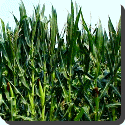 Corn — Maize, usually called corn in some countries, is a cereal grain that was domesticated in Mesoamerica and then spread throughout the American continents. Maize spread to the rest of the world after European contact with the Americas in the late 15th century and early 16th century.
Corn — Maize, usually called corn in some countries, is a cereal grain that was domesticated in Mesoamerica and then spread throughout the American continents. Maize spread to the rest of the world after European contact with the Americas in the late 15th century and early 16th century.
The term maize derives from the Spanish form (maíz) of the indigenous Taino term for the plant, and is the form most commonly heard in the United Kingdom.[1] In the United States, Canada and Australia, the usual term is corn, which originally referred to any grain (and still does in Britain), but which now refers exclusively to maize, having been shortened from the form “Indian corn”.
Maize is the largest crop in all of the Americas (270 million metric tons annually in the U.S. alone). Hybrid maize is preferred by farmers over conventional varieties for its high grain yield, due to heterosis (“hybrid vigour”). While some maize varieties grow 7 metres (23 ft) tall at certain locations, commercial maize has been bred for a height of 2.5 metres (8 ft). Sweet corn is usually shorter than field-corn varieties.
Maize is a facultative long-night plant and flowers in a certain number of growing degree days > 50 °F (10 °C) in the environment to which it is adapted. The magnitude of the influence that long-nights have on the number of days that must pass before maize flowers is genetically prescribed and regulated by the phytochrome system. Photoperiodicity can be eccentric in tropical cultivars, where in the long days at higher latitudes the plants will grow so tall that they will not have enough time to produce seed before they are killed by frost. These characteristics, however, may prove useful in using tropical maize for Biofuels.
The kernel of corn has a pericarp of the fruit fused with the seed coat, typical of the grasses. It is close to a multiple fruit in structure, except that the individual fruits (the kernels) never fuse into a single mass. The grains are about the size of peas, and adhere in regular rows round a white pithy substance, which forms the ear. An ear contains from 200 to 400 kernels, and is from 10–25 centimetres (4–10 inches) in length. They are of various colors: blackish, bluish-gray, red, white and yellow. When ground into flour, maize yields more flour, with much less bran, than wheat does. However, it lacks the protein gluten of wheat and therefore makes baked goods with poor rising capability.
 Kids Portal For Parents India Kids Network
Kids Portal For Parents India Kids Network






